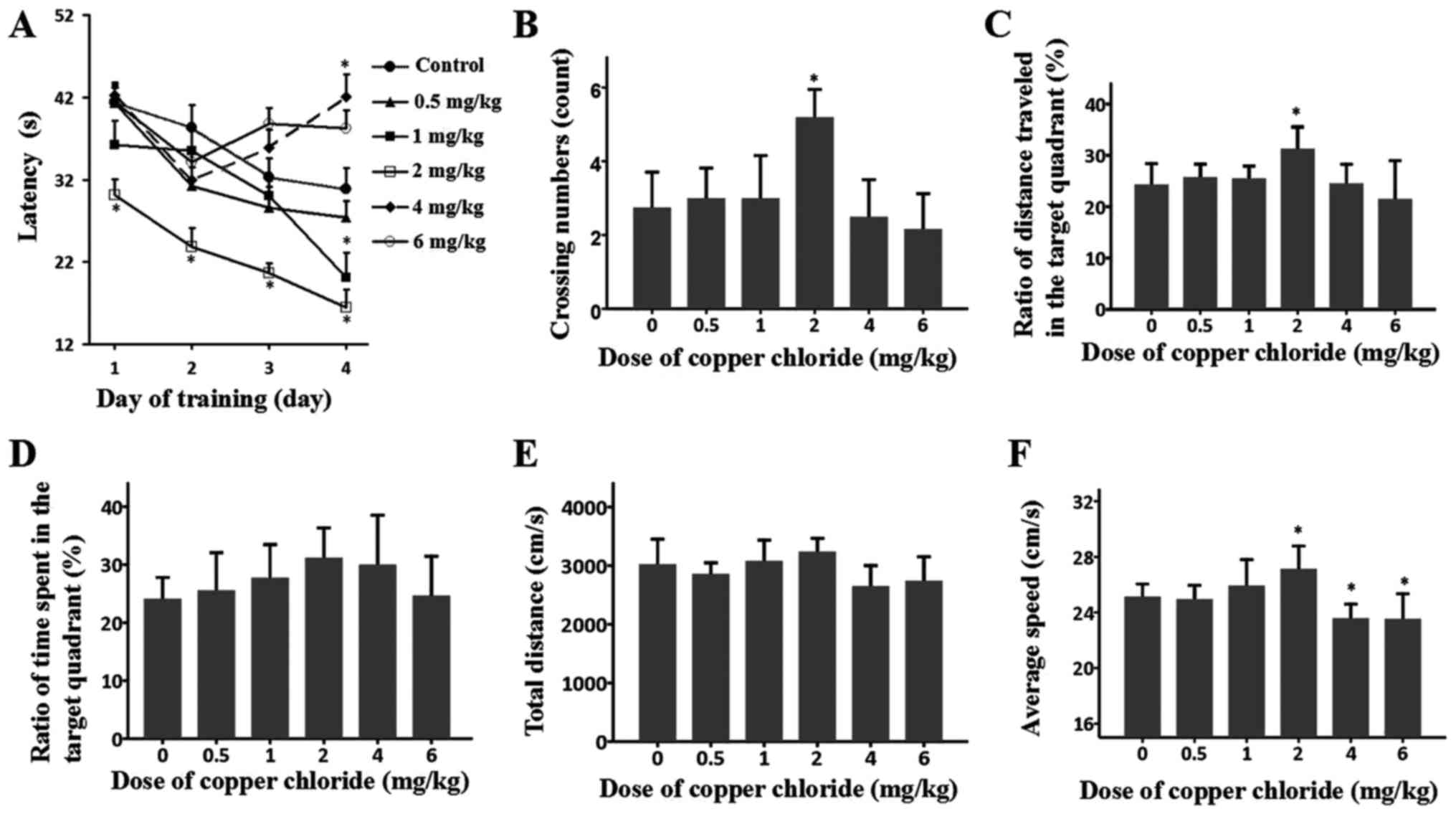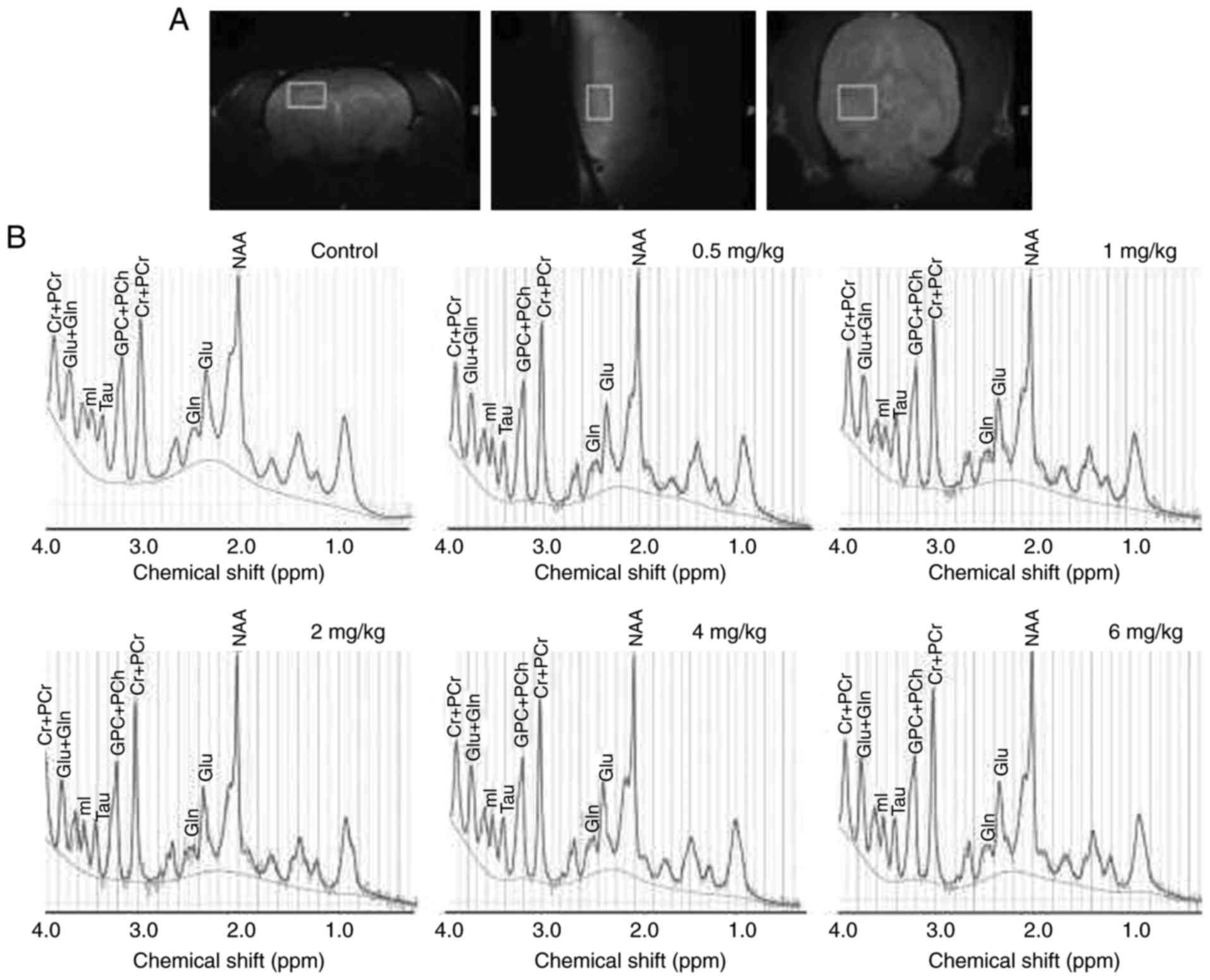|
1
|
Cortese BM, Mitchell TR, Galloway MP,
Prevost KE, Fang J, Moore GJ and Uhde TW: Region-specific
alteration in brain glutamate: Possible relationship to risk-taking
behavior. Physiol Behav. 99:445–450. 2010. View Article : Google Scholar : PubMed/NCBI
|
|
2
|
Prohaska JR: Role of copper transporters
in copper homeostasis. Am J Clin Nutr. 88 Suppl:826S–829S.
2008.PubMed/NCBI
|
|
3
|
Squitti R, Lupoi D, Pasqualetti P, Dal
Forno G, Vernieri F, Chiovenda P, Rossi L, Cortesi M, Cassetta E
and Rossini PM: Elevation of serum copper levels in Alzheimer's
disease. Neurology. 59:1153–1161. 2002. View Article : Google Scholar : PubMed/NCBI
|
|
4
|
Squitti R, Pasqualetti P, Cassetta E, Dal
Forno G, Cesaretti S, Pedace F, Finazzi-Agrό A and Rossini PM:
Elevation of serum copper levels discriminates Alzheimer's disease
from vascular dementia. Neurology. 60:2013–2014. 2003. View Article : Google Scholar : PubMed/NCBI
|
|
5
|
Bush AI: Copper, zinc and the
metallobiology of Alzheimer disease. Alzheimer Dis Assoc Disord.
17:147–150. 2003. View Article : Google Scholar : PubMed/NCBI
|
|
6
|
Brewer GJ: The risks of copper toxicity
contributing to cognitive decline in the aging population and to
Alzheimer's disease. J Am Coll Nutr. 28:238–242. 2009. View Article : Google Scholar : PubMed/NCBI
|
|
7
|
Pal A and Prasad R: Regional distribution
of copper, zinc and iron in brain of Wistar rat model for
non-Wilsonian brain copper toxicosis. Indian J Clin Biochem.
31:93–98. 2016. View Article : Google Scholar : PubMed/NCBI
|
|
8
|
Peters C, Muñoz B, Sepúlveda FJ, Urrutia
J, Quiroz M, Luza S, De Ferrari GV, Aguayo LG and Opazo C: Biphasic
effects of copper on neurotransmission in rat hippocampal neurons.
J Neurochem. 119:78–88. 2011. View Article : Google Scholar : PubMed/NCBI
|
|
9
|
Maas JW and Colburn RW: Co-ordination
chemistry and membrane function with particular reference to the
synapse and catecholamine transport. Nature. 208:41–46. 1965.
View Article : Google Scholar : PubMed/NCBI
|
|
10
|
Mercer JF: Menkes syndrome and animal
models. Am J Clin Nutr. 67 Suppl:1022S–1028S. 1998. View Article : Google Scholar : PubMed/NCBI
|
|
11
|
Mathie A, Sutton GL, Clarke CE and Veale
EL: Zinc and copper: Pharmacological probes and endogenous
modulators of neuronal excitability. Pharmacol Ther. 111:567–583.
2006. View Article : Google Scholar : PubMed/NCBI
|
|
12
|
Salazar-Weber NL and Smith JP: Copper
inhibits NMDA receptor-independent LTP and modulates the
paired-pulse ratio after LTP in mouse Hippocampal slices. Int J
Alzheimers Dis. 2011:8647532011.PubMed/NCBI
|
|
13
|
Trombley PQ and Shepherd GM: Differential
modulation by zinc and copper of amino acid receptors from rat
olfactory bulb neurons. J Neurophysiol. 76:2536–2546. 1996.
View Article : Google Scholar : PubMed/NCBI
|
|
14
|
Vlachová V, Zemková H and Vyklický L Jr:
Copper modulation of NMDA responses in mouse and rat cultured
hippocampal neurons. Eur J Neurosci. 8:2257–2264. 1996. View Article : Google Scholar : PubMed/NCBI
|
|
15
|
Weiser T and Wienrich M: The effects of
copper ions on glutamate receptors in cultured rat cortical
neurons. Brain Res. 742:211–218. 1996. View Article : Google Scholar : PubMed/NCBI
|
|
16
|
Schlief ML and Gitlin JD: Copper
homeostasis in the CNS: A novel link between the NMDA receptor and
copper homeostasis in the hippocampus. Mol Neurobiol. 33:81–90.
2006. View Article : Google Scholar : PubMed/NCBI
|
|
17
|
Morris R: Developments of a water-maze
procedure for studying spatial learning in the rat. J Neurosci
Methods. 11:47–60. 1984. View Article : Google Scholar : PubMed/NCBI
|
|
18
|
Shi L, Adams MM, Long A, Carter CC,
Bennett C, Sonntag WE, Nicolle MM, Robbins M, D'Agostino R and
Brunso-Bechtold JK: Spatial learning and memory deficits after
whole-brain irradiation are associated with changes in NMDA
receptor subunits in the hippocampus. Radiat Res. 166:892–899.
2006. View Article : Google Scholar : PubMed/NCBI
|
|
19
|
Shi L, Olson J, D'Agostino R Jr, Linville
C, Nicolle MM, Robbins ME, Wheeler KT and Brunso-Bechtold JK: Aging
masks detection of radiation-induced brain injury. Brain Res.
1385:307–316. 2011. View Article : Google Scholar : PubMed/NCBI
|
|
20
|
Witter MP and Amaral DG: Hippocampal
formationPaxinos G: The rat nervous system. 3rd. Academic Press;
San Diego: pp. 637–703. 2004
|
|
21
|
Gruetter R: Automatic, localized in vivo
adjustment of all first- and second-order shim coils. Magn Reson
Med. 29:804–811. 1993. View Article : Google Scholar : PubMed/NCBI
|
|
22
|
Harris JL, Yeh HW, Choi IY, Lee P, Berman
NE, Swerdlow RH, Craciunas SC and Brooks WM: Altered neurochemical
profile after traumatic brain injury: (1)H-MRS biomarkers of
pathological mechanisms. J Cereb Blood Flow Metab. 32:2122–2134.
2012. View Article : Google Scholar : PubMed/NCBI
|
|
23
|
Provencher SW: Estimation of metabolite
concentrations from localized in vivo proton NMR spectra. Magn
Reson Med. 30:672–679. 1993. View Article : Google Scholar : PubMed/NCBI
|
|
24
|
Cavassila S, Deval S, Huegen C, van
Ormondt D and Graveron-Demilly D: Cramer-Rao bounds: An evaluation
tool for quantitation. NMR Biomed. 14:278–283. 2001. View Article : Google Scholar : PubMed/NCBI
|
|
25
|
Zhu W, Masaki T, Cheung AK and Kern SE:
In-vitro release of rapamycin from a thermosensitive polymer for
the inhibition of vascular smooth muscle cell proliferation. J
Bioequiv Availab. 1:3–12. 2009.PubMed/NCBI
|
|
26
|
Zhang L, Bai R, Liu Y, Meng L, Li B, Wang
L, Xu L, Le Guyader L and Chen C: The dose-dependent toxicological
effects and potential perturbation on the neurotransmitter
secretion in brain following intranasal instillation of copper
nanoparticles. Nanotoxicology. 6:562–575. 2012. View Article : Google Scholar : PubMed/NCBI
|
|
27
|
Ma Q, Ying M, Sui X, Zhang H, Huang H,
Yang L, Huang X, Zhuang Z, Liu J and Yang X: Chronic copper
exposure causes spatial memory impairment, selective loss of
hippocampal synaptic proteins, and activation of PKR/eIF2α pathway
in mice. J Alzheimers Dis. 43:1413–1427. 2015.PubMed/NCBI
|
|
28
|
Yu J, Luo X, Xu H, Ma Q, Yuan J, Li X,
Chang RC, Qu Z, Huang X, Zhuang Z, et al: Identification of the key
molecules involved in chronic copper exposure-aggravated memory
impairment in transgenic mice of Alzheimer's disease using
proteomic analysis. J Alzheimers Dis. 44:455–469. 2015.PubMed/NCBI
|
|
29
|
Pal A, Badyal RK, Vasishta RK, Attri SV,
Thapa BR and Prasad R: Biochemical, histological, and memory
impairment effects of chronic copper toxicity: A model for
non-Wilsonian brain copper toxicosis in Wistar rat. Biol Trace Elem
Res. 153:257–268. 2013. View Article : Google Scholar : PubMed/NCBI
|
|
30
|
Railey AM, Micheli TL, Wanschura PB and
Flinn JM: Alterations in fear response and spatial memory in pre-
and post-natal zinc supplemented rats: Remediation by copper.
Physiol Behav. 100:95–100. 2010. View Article : Google Scholar : PubMed/NCBI
|
|
31
|
Railey AM, Groeber CM and Flinn JM: The
effect of metals on spatial memory in a transgenic mouse model of
Alzheimer's disease. J Alzheimers Dis. 24:375–381. 2011.PubMed/NCBI
|
|
32
|
Zhang Y, Lu W, Han M, Li H, Luo H, Li W
and Lin Z: Biphasic effects of copper on rat learning and memory in
the morris water maze. Ann Clin Lab Sci. 46:346–352.
2016.PubMed/NCBI
|
|
33
|
Leiva J, Palestini M, Infante C,
Goldschmidt A and Motles E: Copper suppresses hippocampus LTP in
the rat, but does not alter learning or memory in the morris water
maze. Brain Res. 1256:69–75. 2009. View Article : Google Scholar : PubMed/NCBI
|
|
34
|
Shao Y, Yan G, Xuan Y, Peng H, Huang QJ,
Wu R and Xu H: Chronic social isolation decreases glutamate and
glutamine levels and induces oxidative stress in the rat
hippocampus. Behav Brain Res. 282:201–208. 2015. View Article : Google Scholar : PubMed/NCBI
|
|
35
|
Rupsingh R, Borrie M, Smith M, Wells JL
and Bartha R: Reduced hippocampal glutamate in Alzheimer disease.
Neurobiol Aging. 32:802–810. 2011. View Article : Google Scholar : PubMed/NCBI
|
|
36
|
Barnea A, Cho G and Hartter DE: A
correlation between the ligand specificity for 67copper uptake and
for copper-prostaglandin E2 stimulation of the release of
gonadotropin-releasing hormone from median eminence explants.
Endocrinology. 122:1505–1510. 1988. View Article : Google Scholar : PubMed/NCBI
|
|
37
|
Sharonova IN, Vorobjev VS and Haas HL:
High-affinity copper block of GABA(A) receptor-mediated currents in
acutely isolated cerebellar Purkinje cells of the rat. Eur J
Neurosci. 10:522–528. 1998. View Article : Google Scholar : PubMed/NCBI
|
|
38
|
Zhang L, Bai X, Tian H, Zhong L, Ma C,
Zhou Y, Chen S and Li D: Synthesis of antibacterial film
CTS/PVP/TiO2/Ag for drinking water system. Carbohydr Polym.
89:1060–1066. 2012. View Article : Google Scholar : PubMed/NCBI
|
|
39
|
Lanctôt KL, Herrmann N, Mazzotta P, Khan
LR and Ingber N: GABAergic function in Alzheimer's disease:
Evidence for dysfunction and potential as a therapeutic target for
the treatment of behavioural and psychological symptoms of
dementia. Can J Psychiatry. 49:439–453. 2004. View Article : Google Scholar : PubMed/NCBI
|
|
40
|
Gaier ED, Rodriguiz RM, Zhou J, Ralle M,
Wetsel WC, Eipper BA and Mains RE: In vivo and in vitro analyses of
amygdalar function reveal a role for copper. J Neurophysiol.
111:1927–1939. 2014. View Article : Google Scholar : PubMed/NCBI
|
|
41
|
McGee TP, Houston CM and Brickley SG:
Copper block of extrasynaptic GABAA receptors in the mature
cerebellum and striatum. J Neurosci. 33:13431–13435. 2013.
View Article : Google Scholar : PubMed/NCBI
|
|
42
|
Goldhaber SB: Trace element risk
assessment: Essentiality vs. toxicity. Regul Toxicol Pharmacol.
38:232–242. 2003. View Article : Google Scholar : PubMed/NCBI
|
|
43
|
Montesano R, Rajewsky MF, Pegg AE and
Miller E: Development and possible use of immunological techniques
to detect individual exposure to carcinogens: International Agency
for Research on Cancer/International Programme on Chemical Safety
Working Group Report. Cancer Res. 42:5236–5239. 1982.PubMed/NCBI
|
|
44
|
Rosival L and Vargová M: Chemization and
human health. Czech Med. 5:131–136. 1982.PubMed/NCBI
|
|
45
|
Lei R, Wu C, Yang B, Ma H, Shi C, Wang Q,
Wang Q, Yuan Y and Liao M: Integrated metabolomic analysis of the
nano-sized copper particle-induced hepatotoxicity and
nephrotoxicity in rats: A rapid in vivo screening method for
nanotoxicity. Toxicol Appl Pharmacol. 232:292–301. 2008. View Article : Google Scholar : PubMed/NCBI
|
|
46
|
Sharma M: Understanding the mechanism of
toxicity of carbon nanoparticles in humans in the new millennium: A
systemic review. Indian J Occup Environ Med. 14:3–5. 2010.
View Article : Google Scholar : PubMed/NCBI
|













